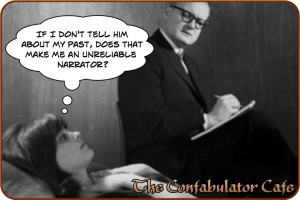 Before I begin to set pen to paper (metaphorically) on my stories, I like to have several conversations with my main character.
Before I begin to set pen to paper (metaphorically) on my stories, I like to have several conversations with my main character.
As with any job interview, questions help me consider whether or not he/she can get the job done. But in truth, these conversations sound more like a prolonged therapy session with a psychiatrist.
Me: So, tell me a little about yourself.
Main Character: Well, I have this weird problem with perception. I can’t read words as they appear. I see words, and I can read them, but they make no sense. The sign at McDonald’s may say “Over one billion served” but I see the words “Dolphin spatula green sycamore.”
Me: I see. So, how long has this problem been going on?
MC: Since my accident, I think. I don’t remember anything about my life before that. My doctor says I must have learned to read at some point, because I can associate words and pictures in my head. I just can’t read them correctly.
Me: And how is this going to make for an interesting story?
MC: Well, lately I’ve been able to read a sign on the side of the road. It seems to be directed at me. It says, “Turn here, Martin.”
Me: That’s rather specific.
MC: Yeah. My doctor thinks it’s a good sign, that my brain is trying to repair itself.
Me: What do you think?
MC: I think it’s kinda creepy. My wife thinks I should ignore it. But I feel like someone’s calling to me. I want to follow the sign.
Once I have a good understanding of what makes my main character unique, I can begin to build a story around him. I need to know some things, but not everything about him before I start. For instance, how did he meet his wife? What kind of life did he have before the accident? Answers to these questions may (or may not) come out in the story. There will be time for additional discovery later.
Depending on the story, I may want to have a similar conversation with my Main Adversary. The MA can be as important as the hero in a story. Think of Lex Luthor in Superman, or Darth Vader in The Empire Strikes Back. Good villains are a counterpoint to heroes. And they have their own reasons, their own motivations, for doing what other people consider “evil.” The trick to writing a villain is to make him/her believable. If they can justify what they’re doing in terms that seem realistic, you probably have someone worth writing about.
Secondary characters don’t need this kind of detail before I begin writing. Often, I will have characters with descriptions like “love interest,” “best friend,” or “receptionist.” They can be fleshed out later, but sometimes not until the second or third draft.
The key is to listen: to my characters, myself, and — probably — to a good shrink to sort out all the voices in my head.


